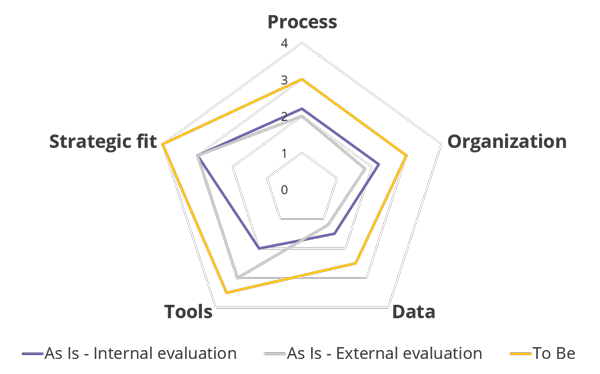
Organizational maturity: learning to walk before trying to run
Steven Depue - September 1, 2020

For those who like to compare supply chain planning with conducting a symphonic orchestra, we like to recommend this curious YouTube video of what appears to be an orchestra of children. They’re playing the opening theme of 2001: A Space Odyssey in such a horrible way that it hurts your ears. One comment suggests that there was actually only one person playing correctly, while all the others clearly had not practiced. Which, if true, would serve as a good story to explain what we call low maturity in the supply chain organization.
Why things can go wrong
Low maturity is a problem we encounter fairly often in companies wanting to take supply chain planning to a higher level. In some of these companies, management believes that all the necessary elements are in place if their supply chain strategy has been defined and is being kept in tune with corporate strategy. Eager to reap the promised benefits, they want to rush into their digital transformation project. But a lot of things still can go wrong from there. Flaws could include the lack of an appropriate supply chain organization, the persistent presence of inadequate processes and practices, and poor availability of reliable supply chain data. Let’s zoom in on this.
Removing organizational flaws
Defining supply chain strategy is one thing, it’s another to put in place the organization that goes along with it. For example, value-stream thinking may be hampered by an inadequate departmental structure and the use of conflicting KPIs. Or staff might not have sufficient expertise. Or they could be opposed to change, possibly due to inadequate insight into and experience with cross-functional collaboration. Or senior management might lack a holistic attitude and approach.
Every potential organizational flaw needs to be examined and addressed prior to launching a digital planning transformation project.
Putting the right processes in place
 In addition to reviewing your organization, you need to clearly define and implement the processes and practices necessary to support your supply chain strategy. We see a lot of companies who are extremely good at executing their plans, but who are less good at formulating their plans to reflect precisely what’s needed. Or their response might be too slow because of the way they plan. There was a recent case where a steel manufacturer wanted to implement a supply chain planning tool, but a preliminary maturity check revealed they lacked a coherent set of business processes to be supported or automated. So, they wisely decided to postpone the planning automation project to focus first on putting the necessary processes in place.
In addition to reviewing your organization, you need to clearly define and implement the processes and practices necessary to support your supply chain strategy. We see a lot of companies who are extremely good at executing their plans, but who are less good at formulating their plans to reflect precisely what’s needed. Or their response might be too slow because of the way they plan. There was a recent case where a steel manufacturer wanted to implement a supply chain planning tool, but a preliminary maturity check revealed they lacked a coherent set of business processes to be supported or automated. So, they wisely decided to postpone the planning automation project to focus first on putting the necessary processes in place.
Bringing the data landscape up to standard
There’s also a data challenge. Even when you have the right strategy, the right organization and the right processes in place, you cannot launch a supply chain intelligence project if you don’t have access to a comprehensive collection of reliable supply chain data. You will not be able to optimize stock levels and accelerate throughputs if your current IT platform or ERP system keeps track of only finished products. In general, you will not be able to add intelligence to inconsistent, incomplete, incorrect or messy master data and production data. Before embarking on a digital supply chain transformation, it’s essential to clearly map the existing data landscape and close any gaps.
Blog post
Holding up a mirror
The maturity challenge is multifaceted. Organizations displaying high maturity in most aspects will still fail to deliver if one aspect is not thoroughly under control.
Unfortunately, a lot of companies tend to overestimate their organizational maturity. It’s not easy for managers to look in the mirror and put a finger on their own flaws. That’s why it’s good for managers to hire external experts who can hold up the mirror for them, identify the flaws and outline the opportunities for improvement, perhaps using a spider chart as shown.

It’s crucial to evaluate your maturity gap in all aspects of supply chain planning [Example of a maturity assessment deliverable by OMP].
Blog post
Managers should certainly not shy away from such an exercise, because it’s a great achievement if they succeed in increasing their organization’s maturity. And the small upfront investment of a maturity assessment avoids rushing into an ill-prepared project.
Don’t mess with the orchestra
The maturity problem is very much like a child wanting to run before being able to walk. Or like an orchestra of underrehearsed children wanting to perform the theme from 2001: A Space Odyssey. We have to admit that the video we highlighted is somewhat misleading. Although the (still) image shows an orchestra and choir of children, what you’re actually hearing is an orchestra of top professional musicians. What they did was switch instruments so that clarinetists were playing trumpets or violins, oboists were playing cellos or timpani, and so forth. It’s hilarious, but we wouldn’t recommend doing this with your supply chain.
How mature is your supply chain? Are you ready to bring your planning to the next level?

Steven Depue
Advisory Manager at OMP BE
Biography
With a background in management consulting and technology implementations, Steven delivers strategic and operational planning advice and customized solutions to meet the supply chain challenges faced by customers worldwide.





